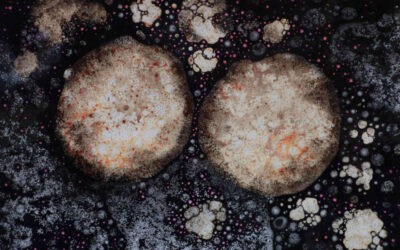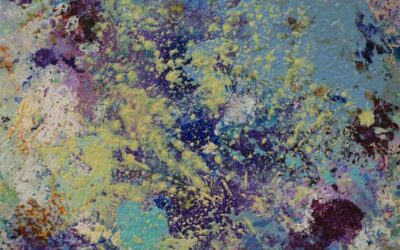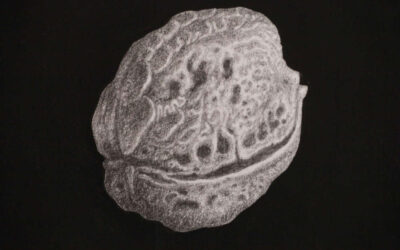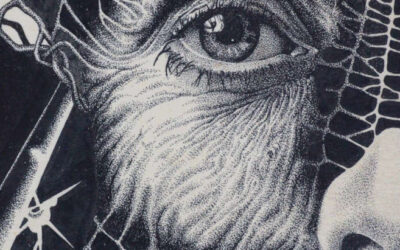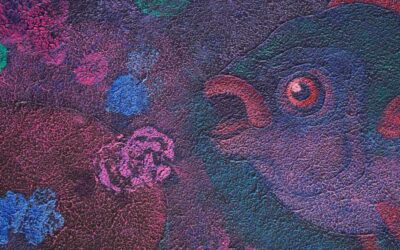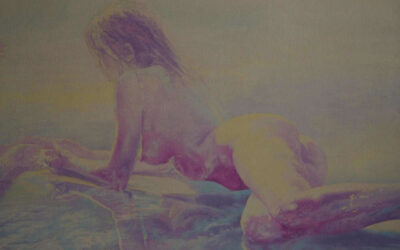Biography
Early Years
Mihridžan Kulenović Mimica was born on 29 November 1946 in Sarajevo, Yugoslavia. From an early age he shows interest in visual arts and drawing. As a teenager he enrols in the High School of Applied Arts in Sarajevo, where he receives his first formal education in fine arts.
Following the obtainment of the high school diploma, Mimica starts developing his artistic identity and exhibiting his work, which evidences an early mastery of paintings skills. In the late 1960s, Mimica moves to Germany, where he showcases his paintings for the first time outside of Yugoslavia.
Upon his return to Sarajevo, Mimica exhibits his artwork more actively across the country. He also spends 1 year in Split where he holds an exhibition at the suggestive Cellars of Diocletian’s Palace.
Throughout the 1960s and the 1970s Mimica’s pictorial style is strongly influenced by the surrealist current and his painting are strikingly articulated and extravagant, a chimerical expression of the unconscious mind.
In the interest of completing his formal education in fine arts, in 1978 Mimica enrols in the Academy of Fine Arts in Sarajevo where he graduates in 1982 from the Department of paintings, in the class of professor Milivoj Unković.
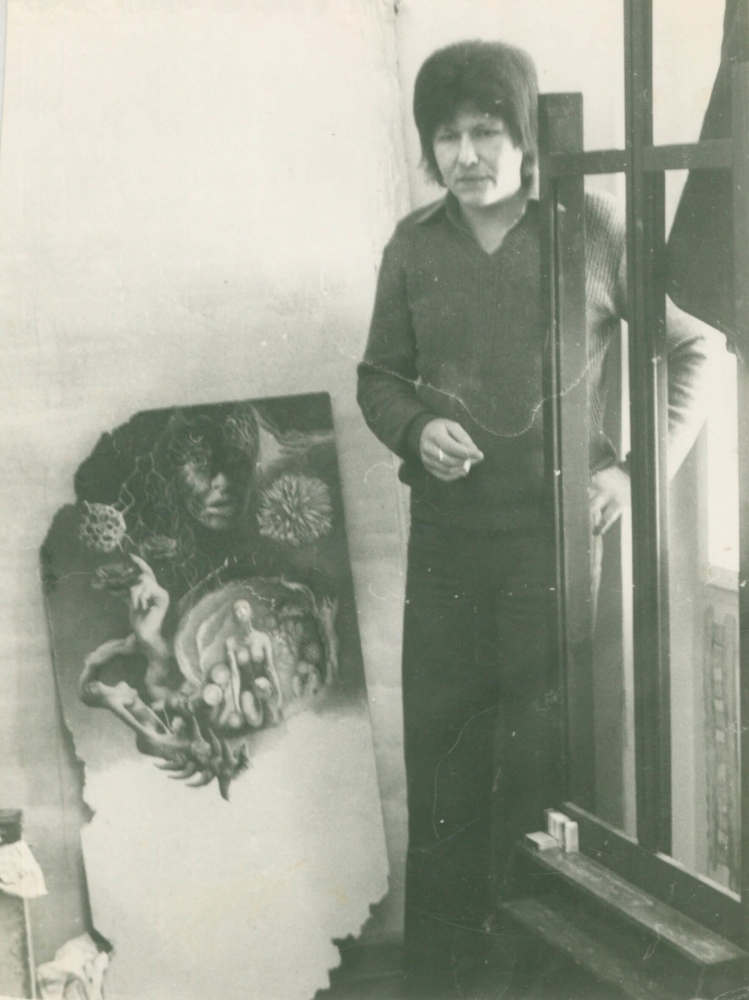
Mihridžan Kulenović Mimica next to one of his early works in the 1970s.
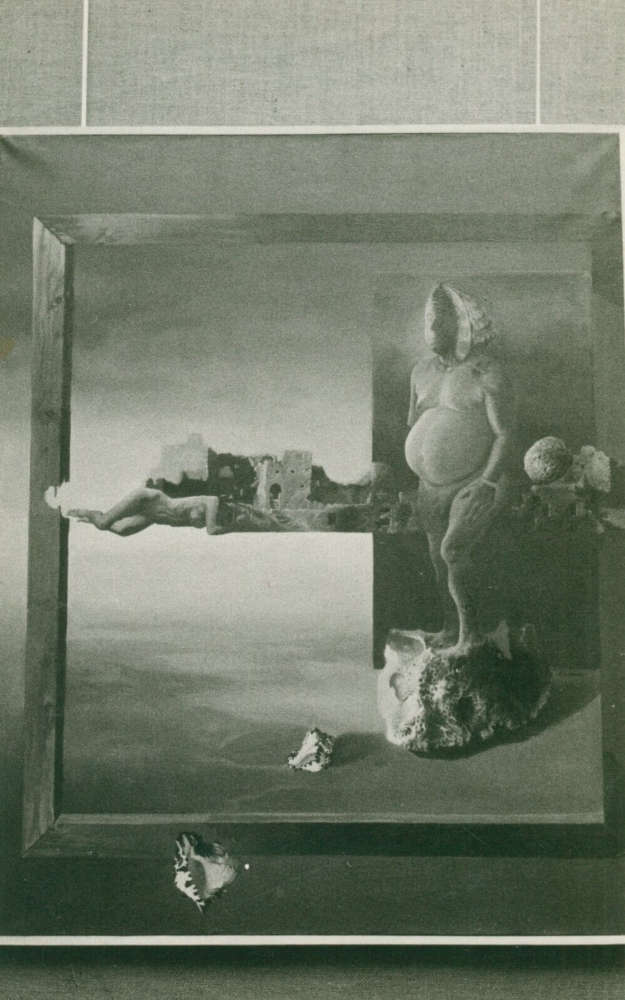
Oil on canvas painting from the 1970s.
The 1980s
Already in the late 1970s Mimica moves more distinctly away from some of the dominant elements and conventions of the surrealist art movement and develops a distinct and unique artistic style. In the early 1980’s, two of Mimica’s most iconic pictorial cycles are born, i.e., ‘Transience of Time’, revolving around the theme of ballerinas and their elegant fluctuation through space and ‘Genesis’, where sexual and orgiastic scenes are animated by the circular motion of all-embracing waves.
The first cycle reflects upon the caducity of time and captures the fleeting instant of a ballet move, a ballet pose, or the graceful execution of a ballet leap. The cycle ‘Genesis’, on the other hand, is an allegory of the process of creation, and the origin of life.
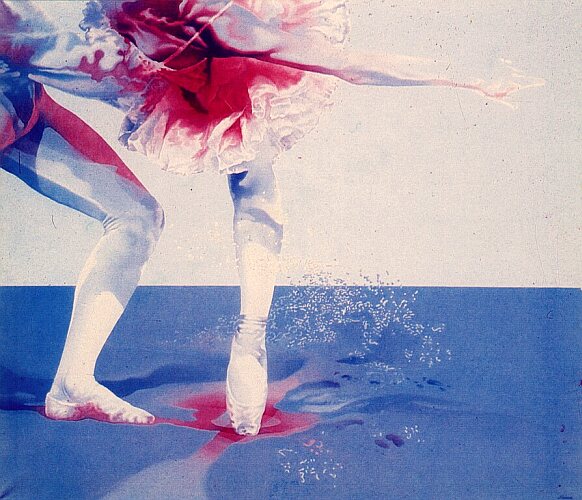
Oil on canvas; from the cycle ‘Transience of time’; 112 x 132 cm; 1982
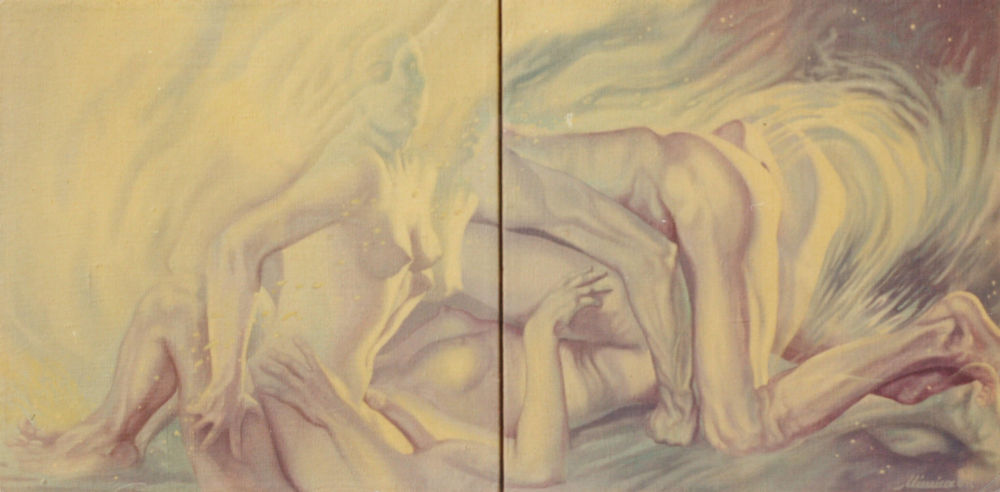
Oil on canvas painting from the pictorial cycle ‘Genesis’.
The two series feature some elements and trends that would become characteristic of Mimica’s work and recur throughout his lifetime’s oeuvre, such as water, celebrated as the driving element of life, sexual imagery and the concept of creation, or the balletic and harmonious dynamism of his central subjects, to name a few. His painting would also continue to preserve a predominantly oneiric and mystical essence.
During the 1980s, Mimica organizes several individual exhibitions and participates in numerous collective exhibitions across the country, most notably in Belgrade in 1986, where Mimica’s artwork is showcased by the national broadcaster and the artist praised by the critic as one of the finest talents of the Bosnian and Yugoslavian art scene.
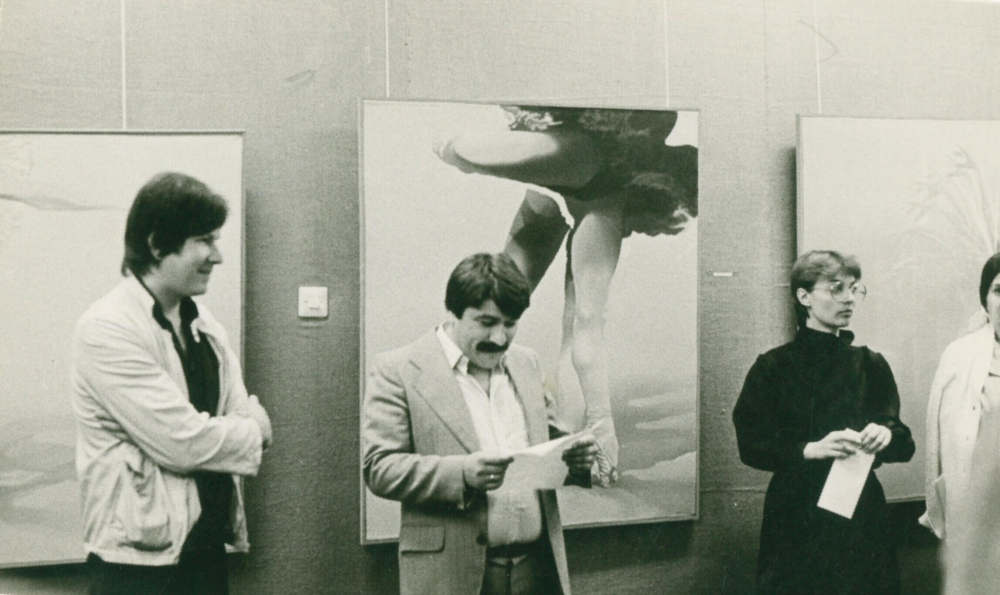
Mihridžan Kulenović Mimica during an exhibition of the pictorial cycle ‘Transience of time’ in the 1980s.
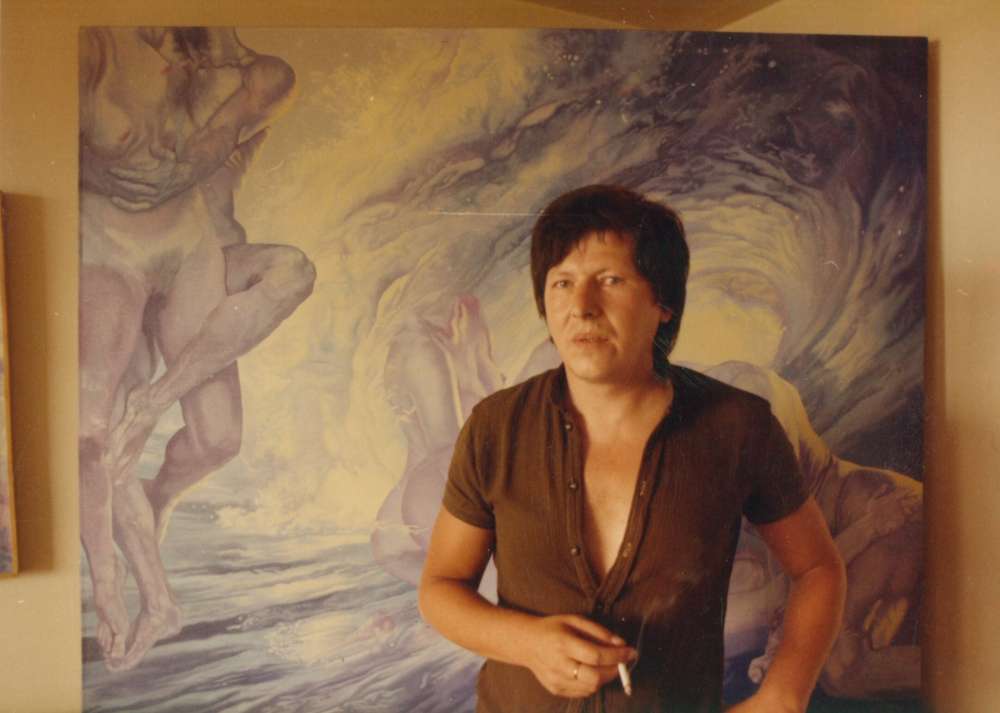
Mimica, in front of his flagship painting from the series ‘Genesis’, singled out by the critic as a major artistic accomplishment.
The 1990s
In 1986 Mimica opens a private art school in Sarajevo, the ‘Dobrinja Art School’ (‘Umjetnička škola Dobrinja’), located in the homonymous Sarajevo’s neighbourhood.
As the siege of Sarajevo begins in 1992, the art school remains open and perseveres with its educational activities, despite the persistent shelling. The school soon becomes a symbol of cultural resistance against the brutality of the war, which contributes to its notoriety.
During the siege, the art school is visited by representatives from international organizations and diplomatic delegations stationed in the city, as well as other international dignitaries, some of whom would buy Mimica’s artwork, such as American actor Harvey Keitel.
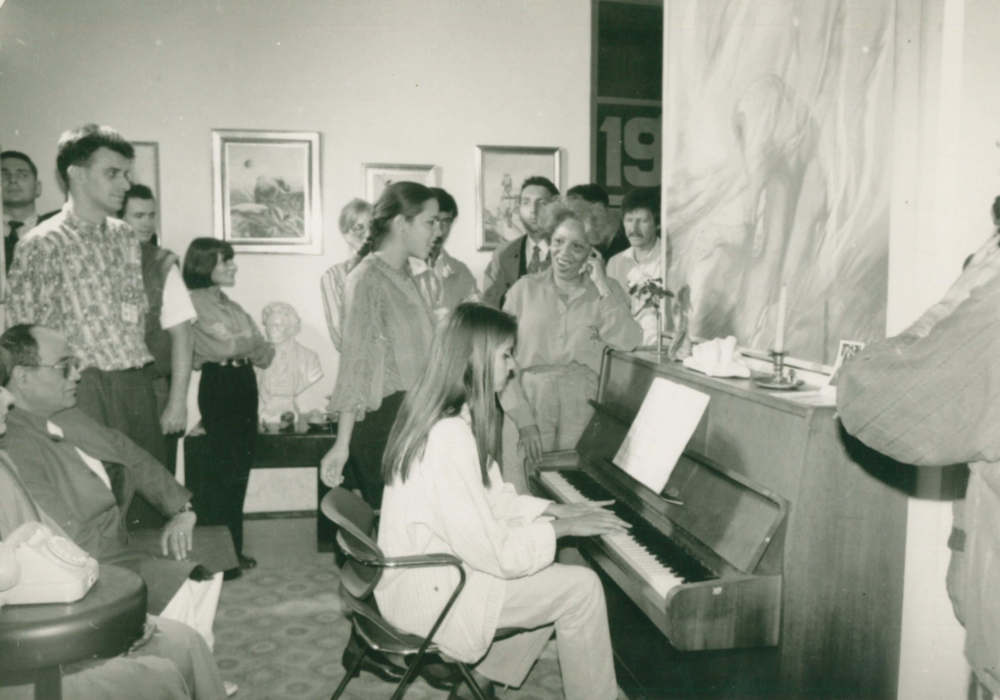
Dobrinja’ art school during the siege of Sarajevo.
During the years of the siege of Sarajevo, Mimica uses his art to denounce the brutality of the war with a series of highly evocative and poignant drawings with ink, reflecting upon the misery and viciousness of the ongoing conflict. Besides their historical significance, the ink drawings are testimony to Mimica’s draftsmanship and meticulous use of pointillism.
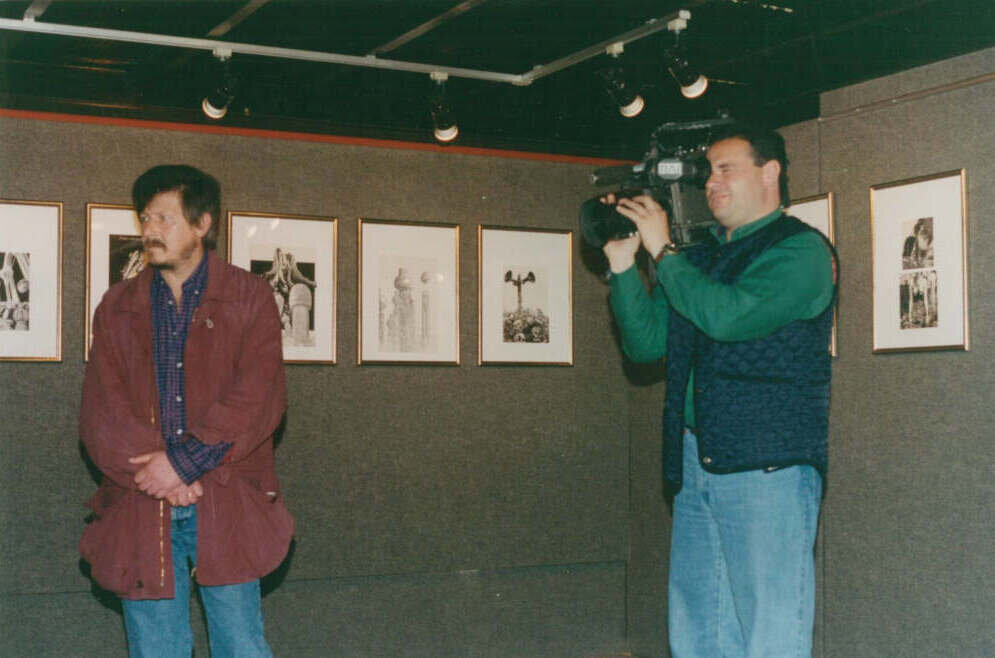
Exhibition in Italy with drawings with ink from the ‘Scream’ pictorial cycle in the background.
Although due to the activities of the art school during the war, Mimica is invited several times to flee the besieged city and hold exhibitions abroad, he repeatedly refuses to leave Sarajevo. Nevertheless, towards the end of the conflict, Mimica along with his students, accepts the invitation of the Art School Nordio in Trieste to come to Italy, to give his students the opportunity to exhibit their artwork and, more importantly, leave the war and continue their education abroad.
Later, Mimica accepts to organize a series of individual exhibitions across Italy, most notably in Trieste, Venice, Parma, Udine and Bolzano. Inspired by the Alps, Mimica also produces a short pictorial cycle called ‘Alpine impressions’, where he plays with oil paint and leaf stamps, thus marking the painting directly with the natural element.
In 1996, upon his return to Sarajevo, Mimica works as an art professor at the Turkish-Bosnian Sarajevo College. Contemporarily, he opens the private School of Fine Arts ‘Monocle’ in the old Sarajevo’s neighbourhood of Baščaršija. After a couple of years, Mimica leaves the position at the Turkish-Bosnian Sarajevo College and focuses entirely on the activities of the private school.
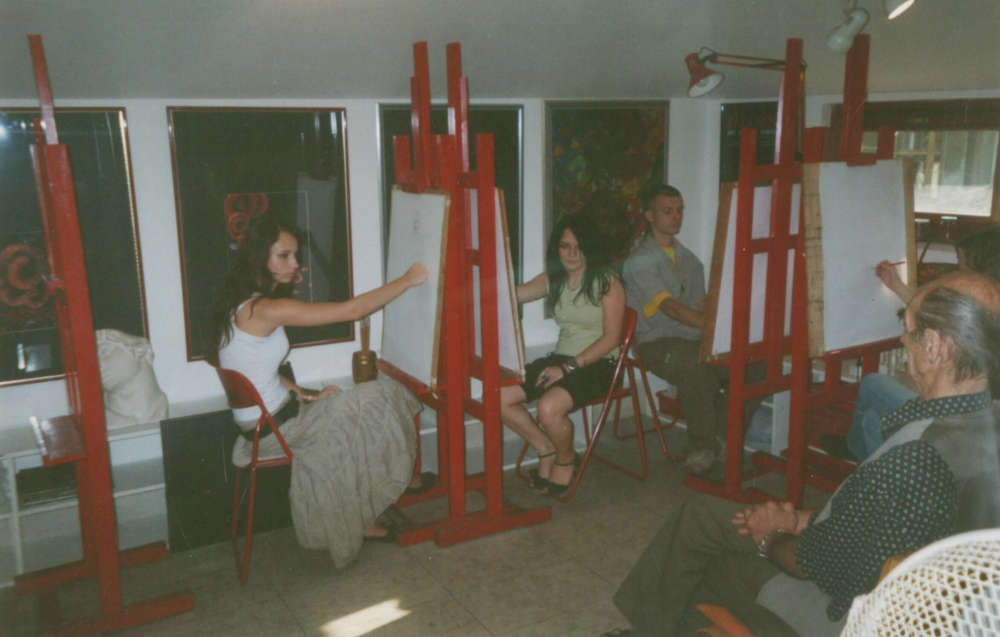
School of Fine Arts ‘Monocle’ during a drawing class.
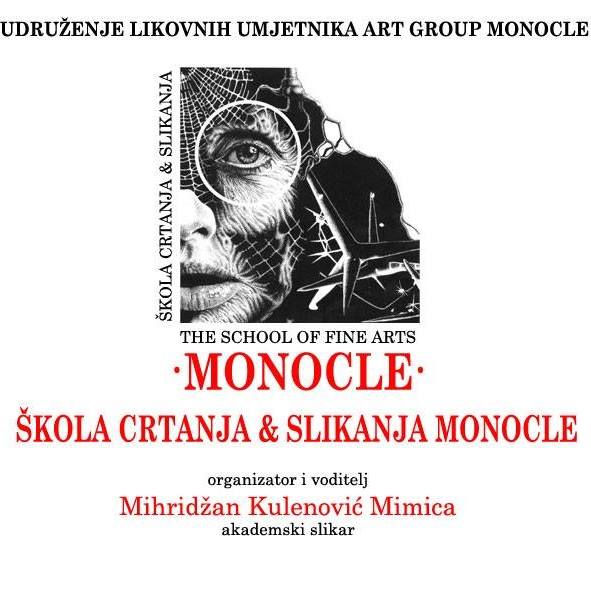
Brochure cover of the School of Fine Arts ‘Monocle’.
Mimica’s return to Sarajevo coincides also with the continuation of the ‘Scream’ pictorial cycle and the production of some of the most suggestive oil on canvas paintings of the series. Throughout the late 1990s and early 2000s Mimica exhibits individually mostly in Sarajevo and, organizes several collective exhibitions of his students’ artwork under the aegis of the Monocle Art School.
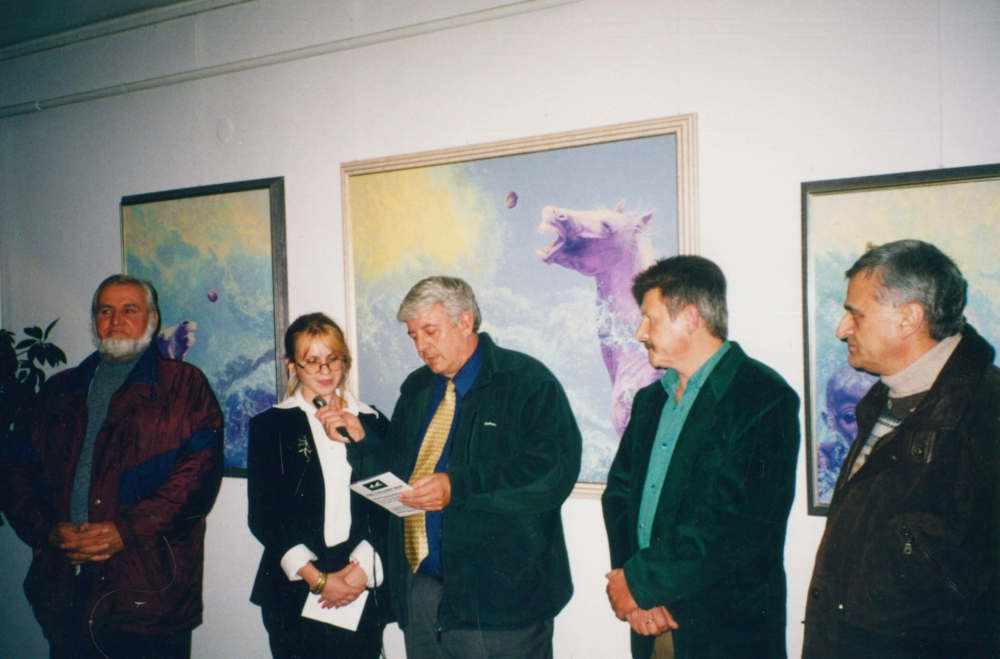
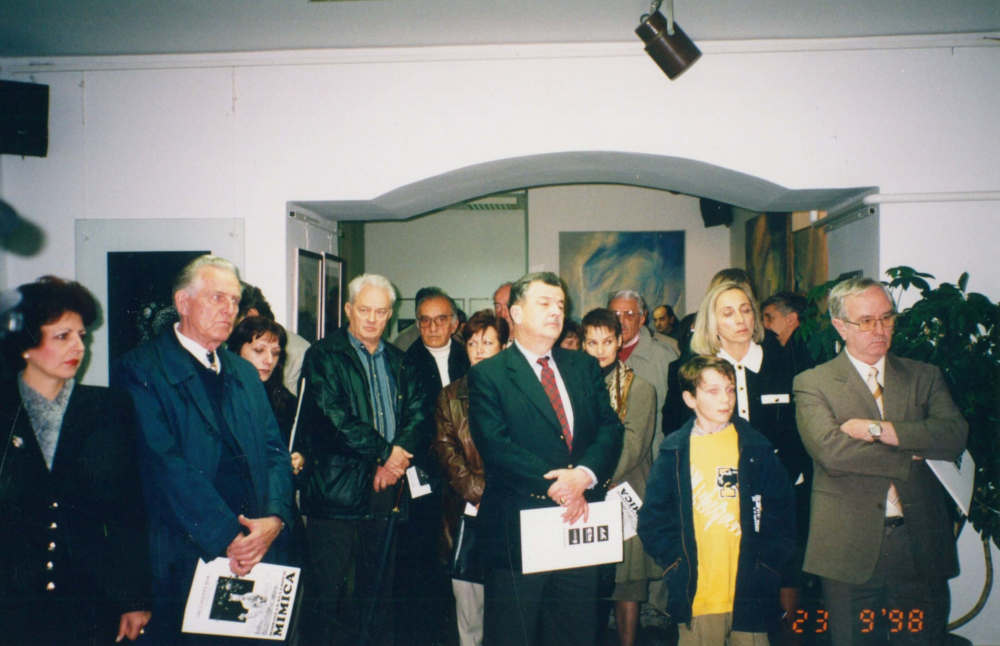
Mimica during an exhibition in Sarajevo in 1998 at the Mak gallery, with paintings from the Scream pictorial cycle in the background.
In the late 1990s, the artist returns to the ‘Genesis’ thematic cycle, and produces an extension of the series started in the 1980s.
While the themes of creation, procreation and the pronounced eroticism retain their focal role, the setting changes drastically as the previous aquatic background is replaced by a cosmogonic fantasy.
Moreover, the continuation of the series is developed using colored ink instead of oil paint.
The series depicts, the gradual creation of the matter, an allegory of the origin of the universe, epitomized by the emerging figure of a cosmic woman. The paintings of the series are tightly connected and, as an ensemble, constitute a coherent visual narration.
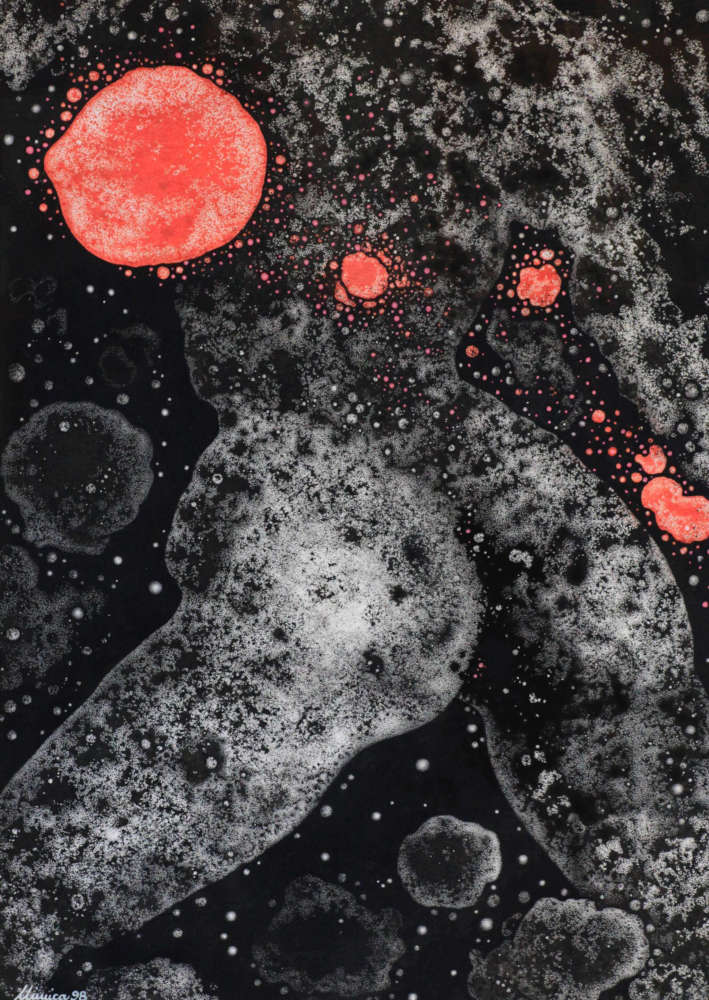
Colored ink; from the cycle ‘Genesis’; 70 x 50 cm; 1998
The 2000s
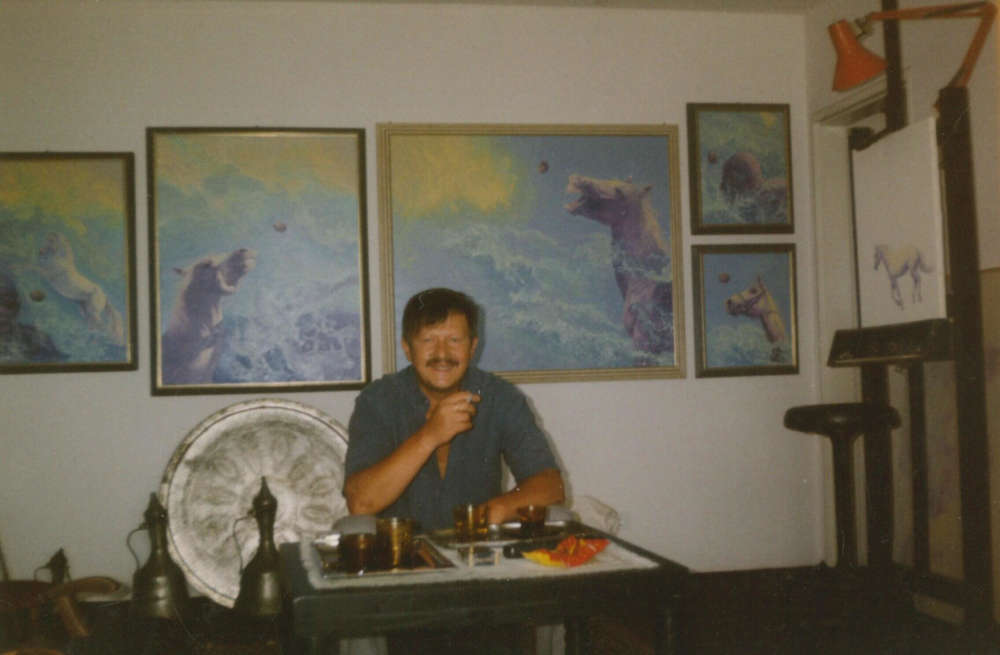
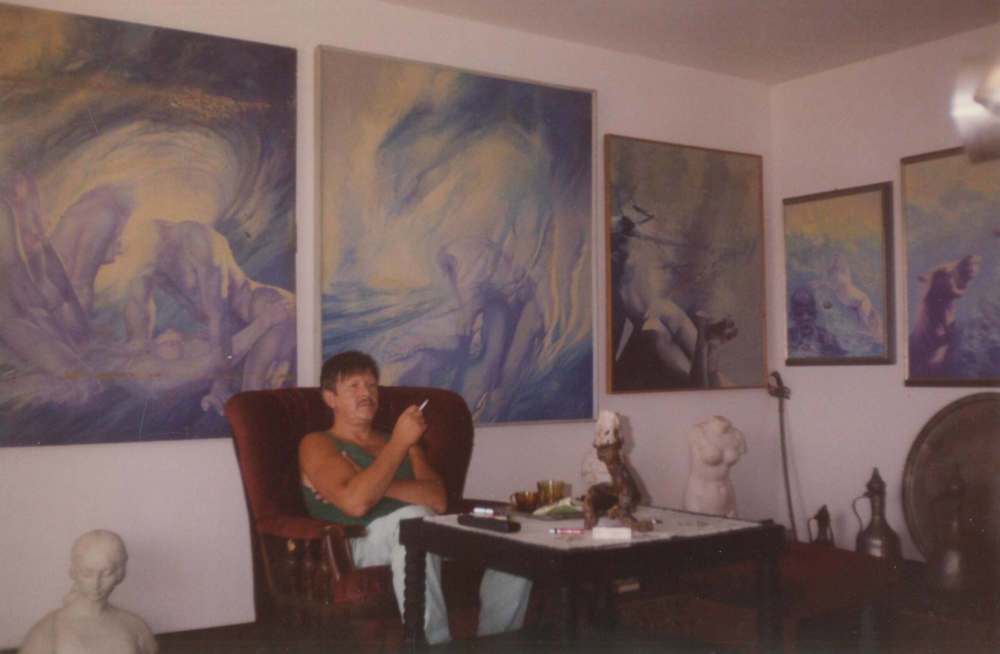
Mihridžan Kulenović Mimica in his atelier.
In 2007 Mimica produces a short series of drawings with pencil, an extension of the ‘Roots’ series. The drawings, as the name of the cycle suggests, mostly depict roots, some floating in the silent void and others firmly attached to the ground.
The silvery pencil drawings stand out solemnly on the black background of the cardboard, suggesting a nocturnal setting.
In the mid 2000s, Mimica starts experimenting with acrylic, a choice that would come to be fruitful as between 2006 and 2009 he develops the pictorial cycle ‘the Graces’, a reference to classical mythology, and further extends the ‘Roots’ cycle.
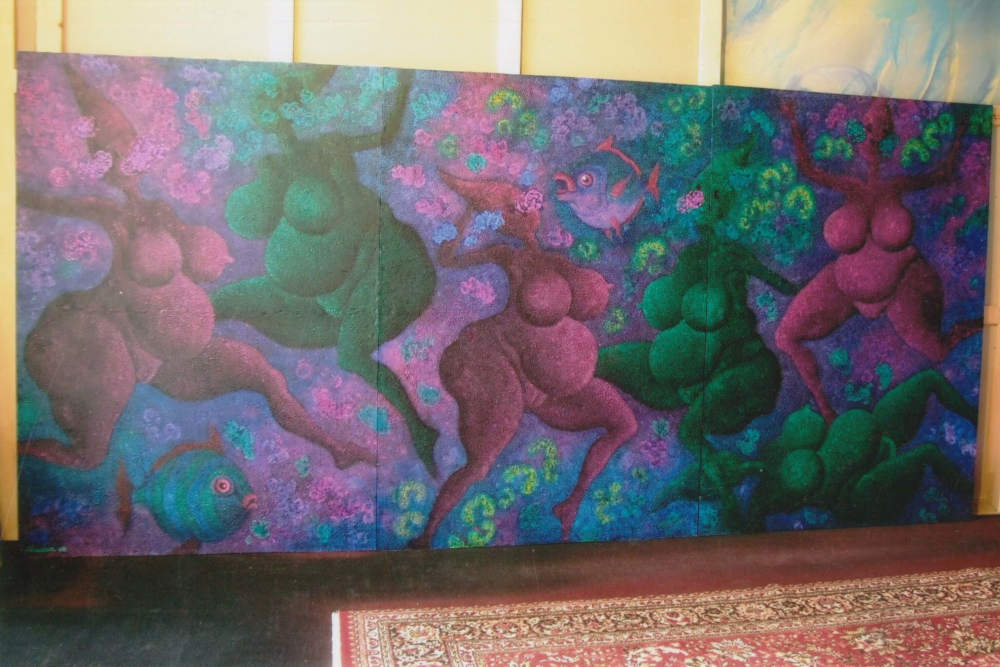
Triptych from the pictorial cycle ‘The Graces’.
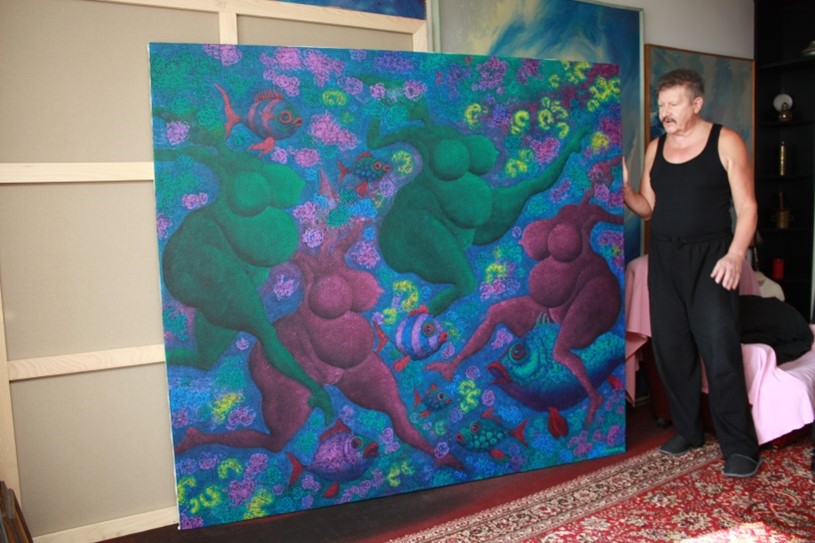
Mihridžan Kulenović Mimica next to an acrylic on canvas painting from the pictorial cycle ‘The Graces’.
In the Graces pictorial cycle, the age-old artistic trope of the Graces, according to classical mythology a group of minor goddesses personifying inter alia, charm, beauty, creativity and fertility, is re-envisioned by the artist and placed in a fantasy underwater world. The graces appear to be graciously dancing and joyfully leaping in the mysterious depths of the artist’s underwater fantasy. The element of the fluid ballet move recurs again as well as the marine setting, already represented in some drawings with ink from the 1990s. The relief texture provided by the acrylic on canvas further enlivens these vivacious compositions.
Later years
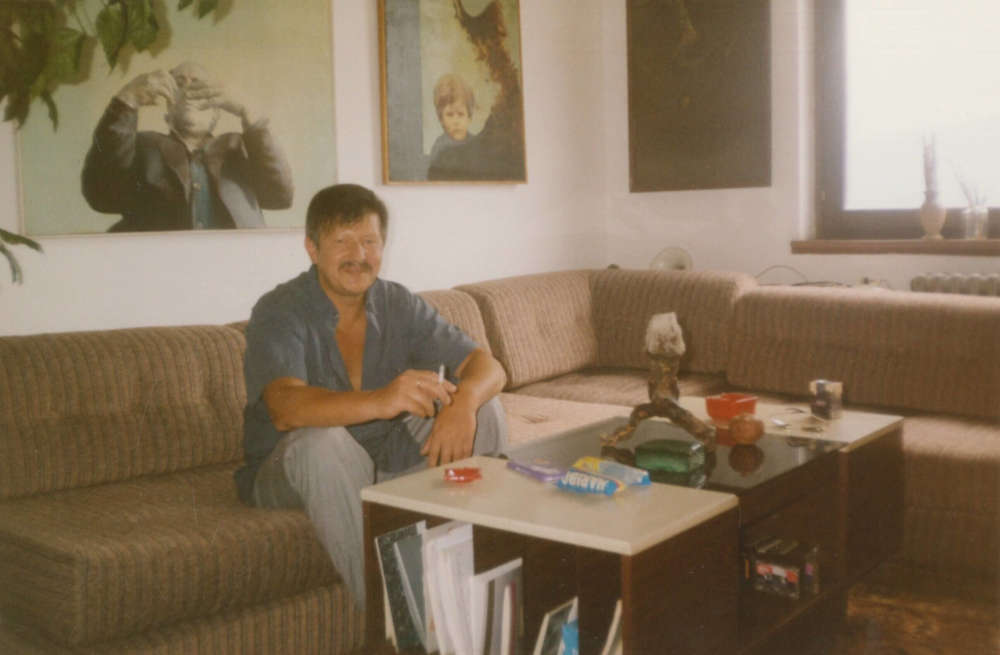
Around 2010, Mimica moves the Art School ‘Monocle’ back to the Dobrinja neighbourhood, closer to his atelier, where he keeps teaching fine arts.
Mihridžan Kulenović Mimica dies in 2019 in Sarajevo.
Mimica was a member of the Association of Bosnia and Herzegovina Fine Artists. Overall, his work has been exhibited at around a hundred individual exhibitions, home and abroad, and many more collective exhibitions.
Nowadays, most of his artwork belongs to the family collection while several other paintings and drawings are held in private collections worldwide.
You May Also Like…
Colored Ink – Details
Scroll down and click on the pictures to view the full images of the close-ups. To view the full paintings, click HERE.You May Also Like...
Other Techniques – Details
Scroll down and click on the pictures to view the full images of the close-ups. To view the full paintings, click HERE.You May Also Like...
Pencil – Details
Scroll down and click on the pictures to view the full images of the close-ups. To view the full pencil drawings, click HERE.You May Also Like...
Ink – Details
Scroll down and click on the pictures to view the full images of the close-ups. To view the full drawings, click HERE.You May Also Like...
Acrylic – Details
Scroll down and click on the pictures to view the full images of the close-ups. To view the full paintings, click HERE.You May Also Like...
Oil on canvas – Details
Scroll down and click on the pictures to view the full images of the close-ups. To view the full paintings, click HERE. You May Also Like...

